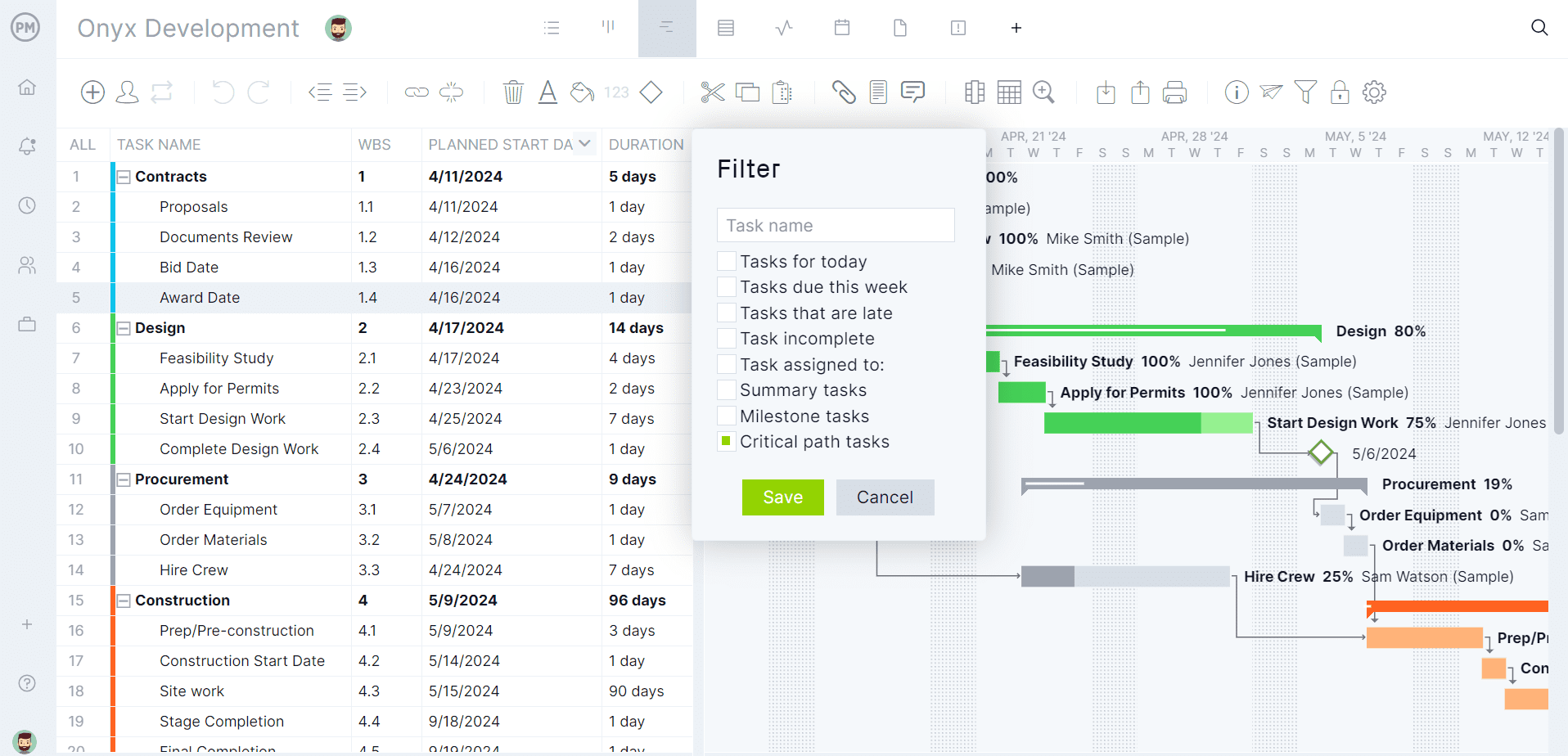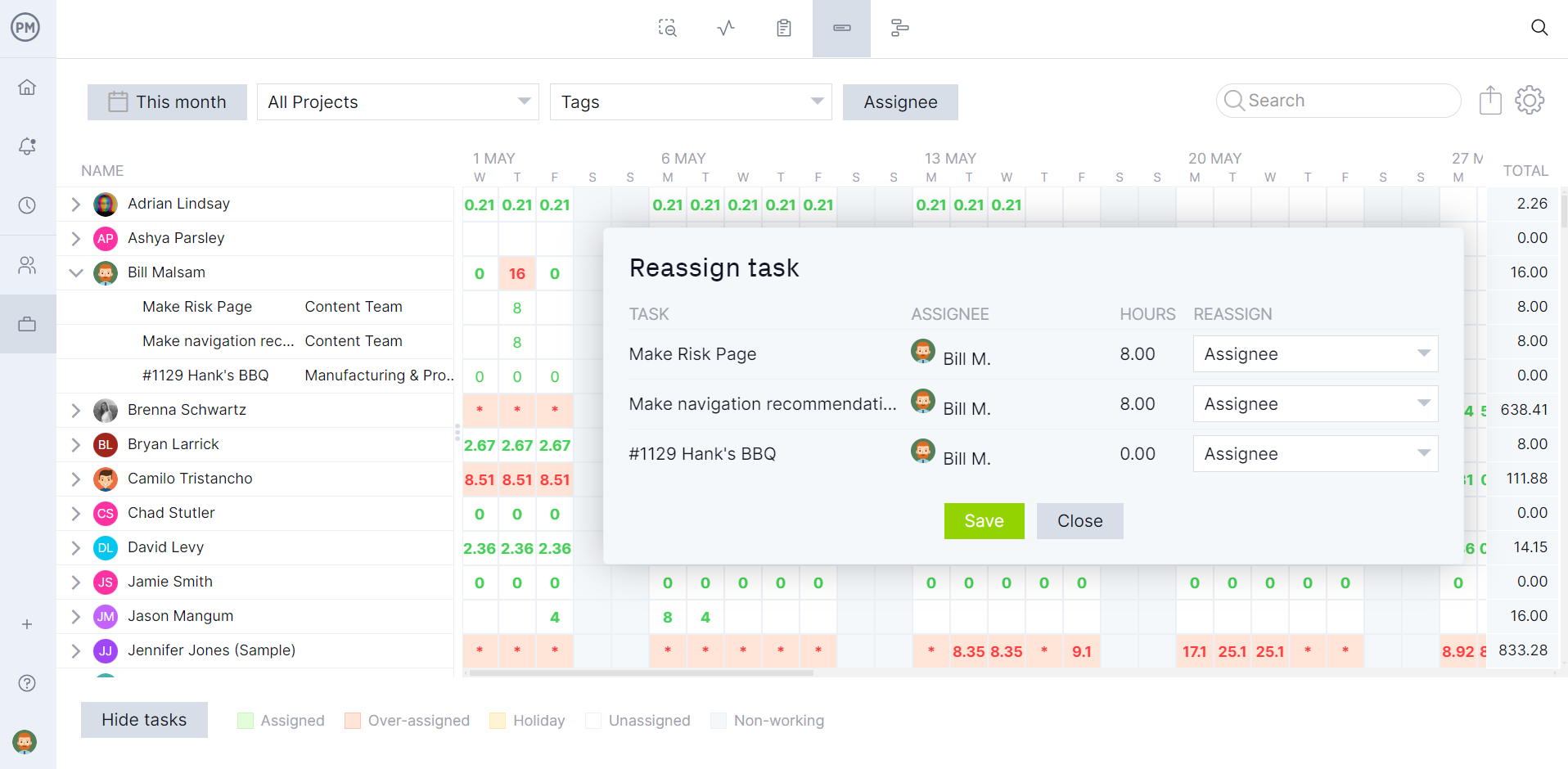Microsoft Project has its critics. The project management software is expensive, complicated and not collaborative. No wonder project teams look for open-source Microsoft Project alternatives. For one thing, it’s (mostly) free. But these products also give Microsoft products a run for their money in terms of features.
Let’s look at several open-source Microsoft Project alternatives and see what they have to offer, where they succeed as project management software and where they fall short. Sometimes a consumer gets what they paid for, which is why we’ll also review a commercial Microsoft Project alternative and see how it stands up against Microsoft Project open source alternatives.
What Is an Open-Source Microsoft Project Alternative?
Because Microsoft Project can be such a pain to use, project managers and their teams seek alternatives. The more technical teams, working in IT and other departments, are familiar with open source and the Linux operating system. They know open-source Microsoft Project alternatives are freely available for anyone to use, modify and distribute.
Many reasons besides Microsoft Project open source alternatives being cost-effective drive the interest in using these tools. They can be easily customizable, modifying source code to fit one’s needs. There’s community support from other users and developers who help improve the product and provide help to resolve issues.
That doesn’t mean it’s a perfect solution for those seeking Microsoft Project open-source alternatives. There are many challenges to consider before leaping into the unknown. The tools have a user interface that isn’t as polished as those found in commercial products. There are limited features. Open-source Microsoft Project alternatives often lack advanced reporting and integrations and aren’t fit for multiple project methodologies. Installation and maintenance can be time-consuming and require technical expertise. There are issues with data security that will worry companies.
ProjectManager Is Better Than an Open-Source Alternative
That’s just a few of the issues that drive users away from Microsoft Project open source alternatives toward commercial project management software. ProjectManager is award-winning project and portfolio management software that can import and export Microsoft Project files (MPP). It’s a collaborative alternative with the same robust features but comes at an affordable price point and an intuitive user interface.
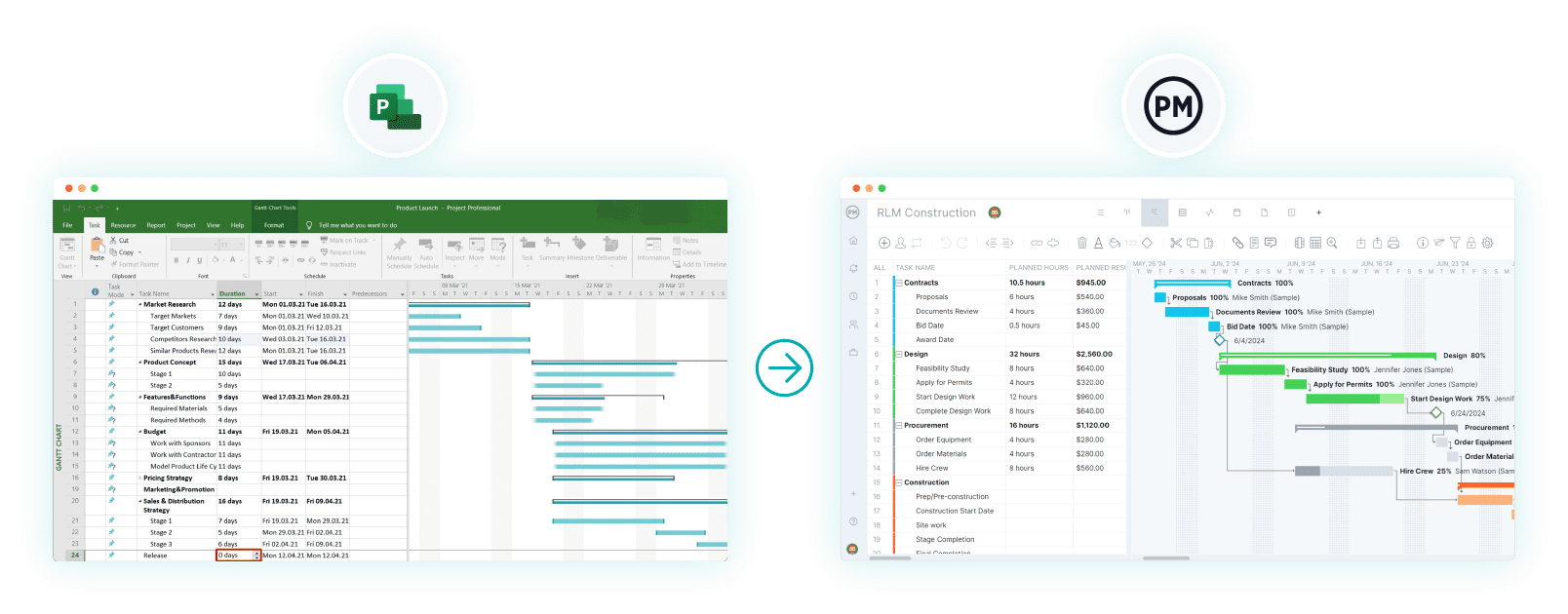
Our software is SOC 2 compliant, providing users with data protection. Many open-source Microsoft Project alternatives can’t handle traditional, agile and hybrid methodologies, but we can. They often don’t have program and portfolio management features, but we do. Our real-time project and portfolio dashboard doesn’t require user setup. It’s ready once users set a baseline on the Gantt chart. Live data is also displayed on easy-to-read graphs and charts showing project metrics, such as time, cost, workload and more.
If you’re simply looking for best-in-class features like task and resource management, you’ll find everything you need to keep your projects and schedules running smoothly. Use the team page to balance resources on the fly and add comments in real time to keep your team looped in on progress. Get started with ProjectManager today for free.
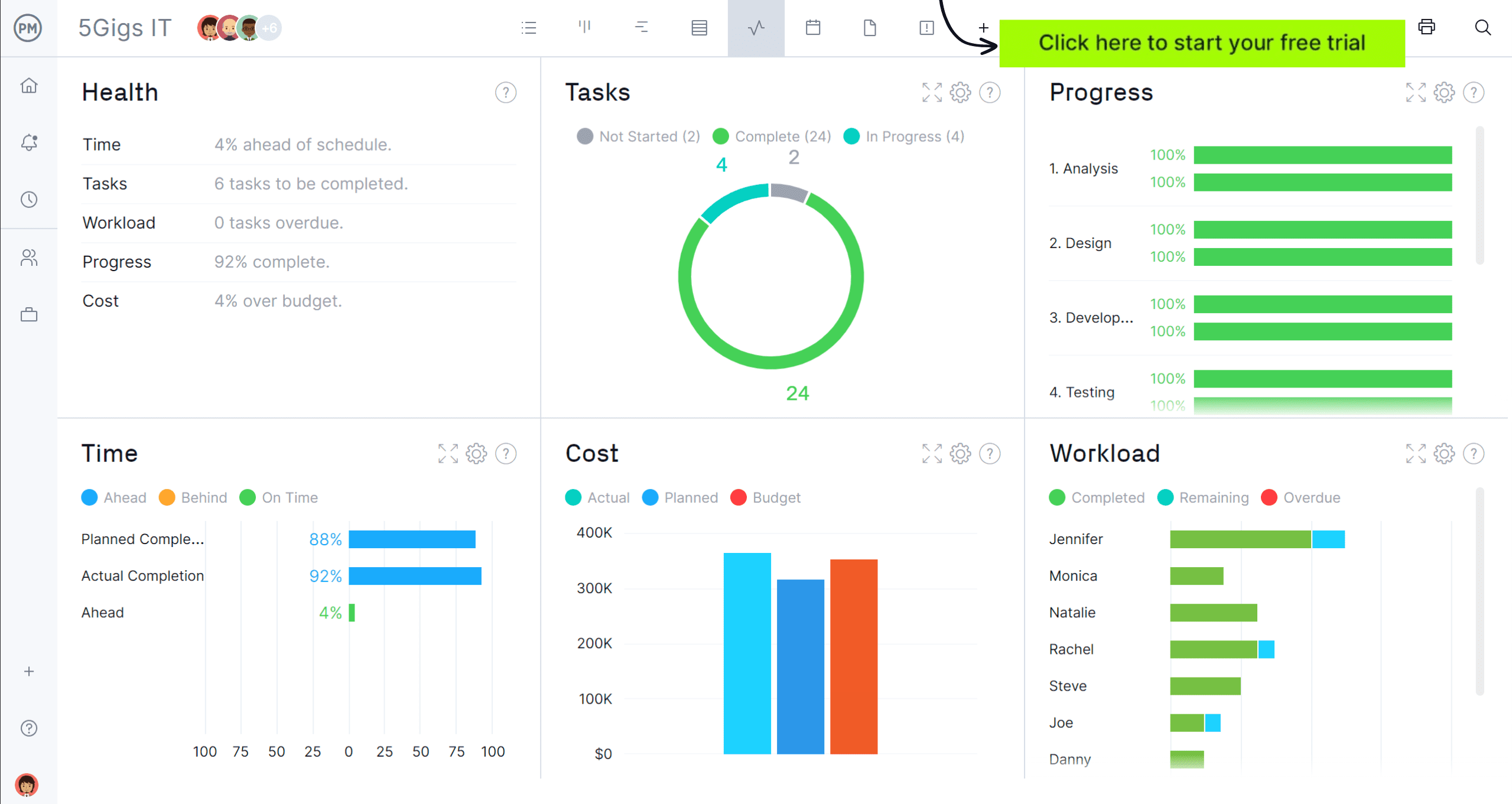
Why Use an Open-Source Microsoft Project Alternative?
For those who aren’t convinced that there’s a need for a Microsoft Project open-source alternative, let’s look at all the issues surrounding project management software solutions. One issue is the steep learning curve. Whether new to project management or a seasoned professional, the highly technical nature of the software is difficult to use.
Then some users want the flexibility of a mobile application. They’ll have to look elsewhere. Microsoft Project has no mobile application, not for Android or iOS. Yes, even in this day and age where everyone’s on their phone and workers are often required to log hours from the job site, Microsoft Project doesn’t see a need for a mobile application.
Projects rely on communication, but Microsoft Project seems to have forgotten this. They have no collaborative tools. To collaborate, team members must pay for add-ons, such as Teams, Outlook or Slack. It’s not the most elegant way to work together, especially as one must leave Microsoft Project and their work to collaborate with other team members.
Microsoft Project isn’t only expensive, but its pricing plans are confusing. Users have to pay for multiple licenses, which adds up. Then there are the various plans that are hard to understand. That alone will send users to a Microsoft Project open-source alternative. Additionally, the software is incompatible with Apple products and most throw their hands up and seek an open-source Microsoft Project alternative.
Benefits of Using a Microsoft Project Open-Source Alternative
We touched on the advantages of open-source Microsoft Project alternatives, but now that we’ve beaten up Microsoft Project, it makes sense to get back to the benefits of a Microsoft Project open-source alternative to understand its popularity.
- Most open-source Microsoft Project alternatives are free, though some require a fee for more advanced project management tools
- Flexible and customizable open-source software allows users to modify code to fit one’s workflow and requirements, which gives one greater control than Microsoft Project offers
- Support comes from a community of developers and users who upgrade the software and respond to issues, though this can be spotty and not as reliable as commercial product support
- No vendor lock-in tying users to a specific vendor, allowing for greater independence and the ability to switch tools or host solutions as needed
- Transparency allows users to review code for security vulnerabilities
- Frequently updated and the product incorporates innovations regularly
- Open standards make it easier to integrate with other systems and tools without the constraints of proprietary formats
- Collaborative features facilitate teams working together
Disadvantages of Using a Microsoft Project Open-Source Alternative
That doesn’t mean open-source Microsoft Project alternatives are perfect. Far from it. One reason users find themselves migrating from it to ProjectManager is that there are many disadvantages to open-source Microsoft Project alternatives. Here are just a few.
- Limited advanced features, such as built-in reports, resource and portfolio management features. Microsoft Project just gets more expensive to use as it forces one to integrate with other tools, such as SharePoint, Teams, etc.
- Security concerns as users are responsible for data security and compliance, which can lead to vulnerabilities
- Data ownership and control means organizations must manage data hosting and server infrastructure and exporting data from one tool to another can be complicated
- Compatibility and integration issues with other enterprise software suites like Microsoft 365, which are often part of a company’s corporate tools
- Steep learning curve, just like Microsoft Project, but Microsoft Project open source alternatives require a greater technical knowledge to configure or fully use
- Support is community-based, which can be slow and less reliable in addressing critical issues
- User interface is less polished and modern than those found in commercial products
- Installation and maintenance require technical expertise and users are responsible for ongoing maintenance, such as software updates, security patches and backups
- Lack of integrations with popular tools and platforms and if available might require custom development, adding complexity and cost
- Scalability issues with larger, more complex projects
- Resource intensive when setting up and an ongoing investment in time and resources to keep software functional and secure
4 Best Free Open-Source Microsoft Project Alternatives
That said, several Microsoft Project open-source alternatives might be attractive to users looking for a cheaper project management tool. We tested the four most popular brands of open-source Microsoft Project alternatives to help one make an informed decision.
1. ProjectLibre
ProjectLibre is a Microsoft Project open-source alternative that is a desktop application with multiple project views, resource, task and cost management features. It can also import and export MPP files as well as XML and CSV files.
Related: What Is ProjectLibre? Pros, Cons & Alternatives
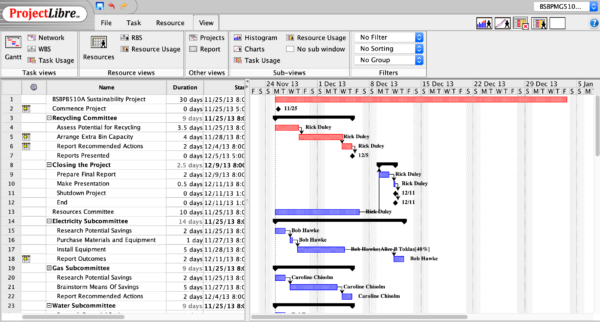
ProjectLibre Pros & Key Features
- Works with Windows, Mac and Linux operating systems
- Gantt chart links dependencies, does critical path analysis and can set a baseline
- Creates, assigns and tracks tasks
- Allocates resources
ProjectLibre Cons & Limitations
- No advanced reporting or sophisticated resource leveling
- Basic software is free, but more advanced features and support come at a cost
- Lacks real-time collaboration
- Performance issues with larger, complex projects
- Lacks version control
- No cloud features for storage
ProjectLibre Reviews
- G2: 4.2
- Capterra: 4.4
2. OpenProject
OpenProject is an open-source Microsoft Project alternative designed for traditional, agile or hybrid project management methodologies. It’s a collaborative tool that has project tracking and features Gantt charts, task lists and kanban boards.
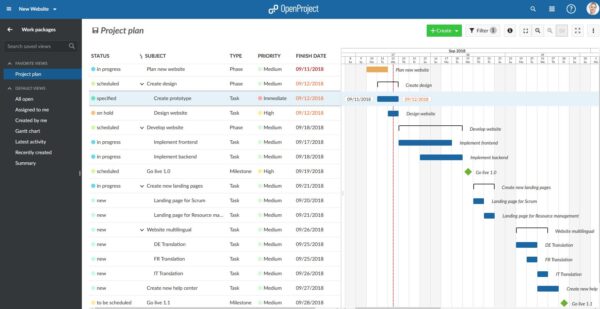
OpenProject Pros & Key Features
- Features include task management, timelines, Gantt charts, time tracking and reporting
- Collaborative platform with messaging, document sharing and project forums
- Works in a multitude of project management methodologies
- Has scrum boards and flexible workflow management
OpenProject Cons & Limitations
- Free tier, but other subscriptions with robust tools are expensive
- Complex and hard to set up
- Performance issues with larger projects
- Poor or missing resource and portfolio management features
- Buggy mobile application
- Resource intensive for self-hosted deployment
OpenProject Reviews
- G2: 3.8
- Caterra: 4.5
3. GanttProject
GanttProject is a Microsoft Project open-source alternative that focuses on making and managing Gantt charts. Its Gantt charts can identify task dependencies and support critical path analysis and baseline comparison.
Related: What Is GanttProject? Pros, Cons & Alternatives
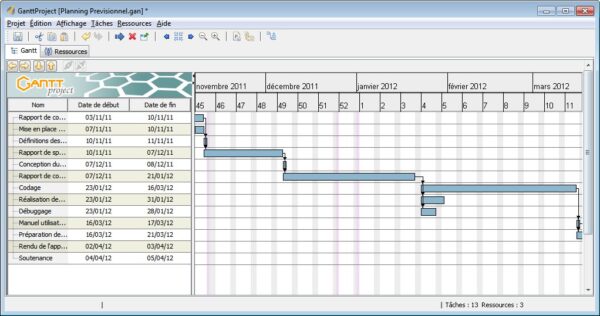
OpenProject Pros & Key Feature
- Robust Gantt charts
- Task management features
- Tracks resource availability and workload
- Export and print Gantt charts to PDF, PNG and CSV formats, including MPP
OpenProject Cons & Limitations
- Limited resource, financial and risk management features
- Limited integration with other tools
- No mobile access for this desktop-only application
- Lacks advanced security to safeguard data
- No built-in collaboration tools
- Learning curve for those unfamiliar with the Gantt chart
GanttProject Reviews
- G2: 4.3
- Capterra: 4.2
4. Redmine
Redmine is an open-source Microsoft Project alternative with issue tracking. It’s a web-based tool that facilitates collaboration and has features, such as Gantt charts, calendars and more. It can be used for general project management or software development projects.
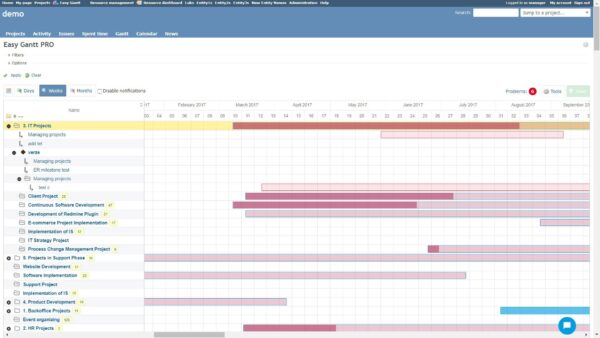
Redmine Pros & Key Features
- Create, assign and manage tasks or issues
- Rich reporting and tracking of issues, tasks and project progress
- Time tracking on tasks for better resource management
- Email notifications about changes, updates and deadlines
Redmine Cons & Limitations
- Limited built-in features lacking without paying for plug-ins
- Setup requires technical knowledge, web server configurations, database management, etc.
- Reporting limitations, again requiring buying plug-ins to close the gap with commercial products
- Lacks advanced resource management features, such as capacity planning and workload balancing
- No mobile application
- Kanban boards only exist as plug-ins, which still aren’t fully functional
Redmine Reviews
- G2: 4.0
- Capterra: 4.1
ProjectManager Is Better Than Open-Source Microsoft Project Alternatives
When it comes down to open-source Microsoft Project alternatives, they’re not as free as they seem to be. Users either have to pay for add-ons or a higher-tier subscription to get the features they want. Some of those features are good, but others fall short. Unless a user is a big-time techie who wants to get under the hood and customize their software, a better solution is ProjectManager.
Our software works with Windows, Mac and Linux operating systems, can import and export MPP files if the organization is wedded to Microsoft and has a more robust feature set than any of the reviewed Microsoft Project open-source alternatives. Do they have task, resource, risk and portfolio management all in one tool with a mobile device that works on iOS and Android? We do. Are they SOC 2 compliant to ensure project data is safe? We are. We’re as collaborative as they are, with email and in-app notifications.
Plan, Execute and Manage Projects With Multiple Views
Our Gantt charts are just as powerful as open-source Microsoft Project alternatives, linking all four task dependencies, filtering for the critical path and setting a baseline to track project variance in real time. Project managers can organize tasks and resources and set costs, but teams don’t need all those bells and whistles. That’s why we have kanban boards to visualize workflow, plan sprints and manage backlogs. Task lists allow team members to manage their work and the calendar view provides an overview for stakeholders.

Manage Resources and Labor Costs
While many of the open-source Microsoft Project alternatives have some degree of resource management, they pale in comparison to our software. The benefits begin when onboarding the team. Project managers can set their availability, including PTO, vacation and global holidays for remote workers. Once the team has been assigned tasks, managers can get a live overview of the resource utilization on the team page or the color-coded workload chart. This makes it easy to see at a glance who is overallocated and who is underutilized. Then managers can balance their workload to keep them productive. Secure timesheets do more than streamline payroll, they provide a window into labor costs and the percentage complete for each team member’s tasks.

Related Microsoft Project Content
Sticking with Microsoft Project? That’s understandable. It’s a popular project management software. However, its faults outweigh the benefits. Check out these recent posts that look into Microsoft Project and other Microsoft products as well as alternatives to them.
- What Is Microsoft Project? Uses, Features and Pricing
- 20 Best Microsoft Project Alternatives: Free & Paid Options
- Microsoft Project Viewer – View & Edit MPP Files Online
- Microsoft Project Online: Pros, Cons and Best Alternatives
- Microsoft Project Gantt Chart: A How-to Guide
ProjectManager is online project and portfolio management software that connects teams whether they’re in the office, out in the field or anywhere in the world. They can share files, comment at the task level and stay updated with email and in-app notifications. Join teams at Avis, Nestle and Siemens who use our software to deliver successful projects. Get started with ProjectManager today for free.



